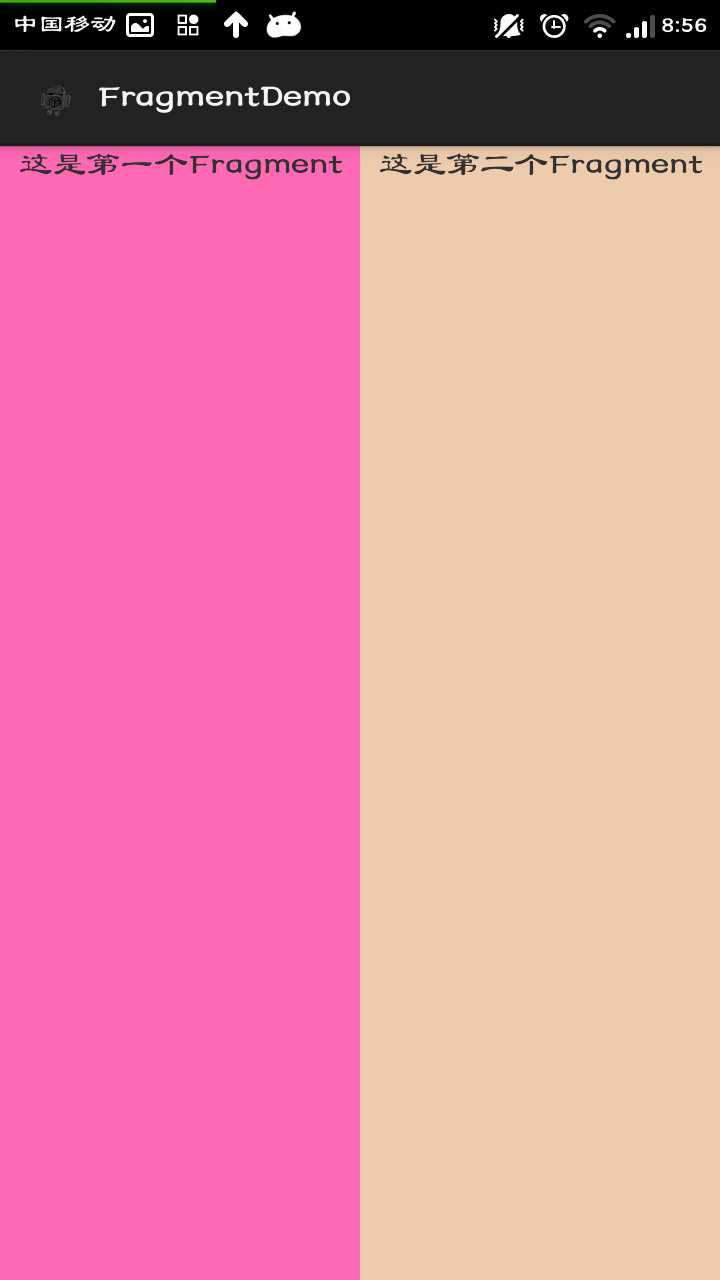标签:
一直知道Fragment非常强大。可是一直都没有去学习,如今有些空暇的时间,所以就去学习了一下Fragment的简单入门。我也会把自己的学习过程写下来,假设有什么不足的地方希望大牛指正,共同进步。
1.Fragment作为Activity界面的一部分组成出现;
2.能够在一个Activity中同一时候出现多个Fragment,而且,一个Fragment亦可在多个Activity中使用;
3.在Activity执行过程中,能够加入、移除或者替换Fragment(add()、remove()、replace());
4.Fragment能够响应自己的输入事件,而且有自己的生命周期,当然。它们的生命周期直接被其所属的activity的生命周期影响。
那我们为什么要用Fragment呢?主要目的是用在大屏幕设备上--比如平板电脑上,支持更加动态和灵活的UI设计。平板电脑的屏幕要比手机的大得多,有很多其它的空间来放很多其它的UI组件,而且这些组件之间会产生很多其它的交互。我们能够把Fragment觉得是“小的Activity”。Fragment更加简洁。
那我们就简单的显示2个Fragment为例来解说一下。
新建Fragment1、Fragment2(注意:这里可能有2个包能够选择导入android.app.Fragment或android.support.v4.app.Fragment都是能够的,我这里选择使用了前者。可是两者使用时有差别的,在结尾中我会讲到):
package com.example.fragment;
import android.app.Fragment;
import android.os.Bundle;
import android.util.Log;
import android.view.LayoutInflater;
import android.view.View;
import android.view.ViewGroup;
import com.example.fragmentdemo.R;
public class Fragment1 extends Fragment {
@Override
public View onCreateView(LayoutInflater inflater, ViewGroup container,
Bundle savedInstanceState) {
Log.e("TAG", "in");
return inflater.inflate(R.layout.fragment1, container, false);
}
}package com.example.fragment;
import android.app.Fragment;
import android.os.Bundle;
import android.view.LayoutInflater;
import android.view.View;
import android.view.ViewGroup;
import com.example.fragmentdemo.R;
public class Fragment2 extends Fragment {
@Override
public View onCreateView(LayoutInflater inflater, ViewGroup container,
Bundle savedInstanceState) {
return inflater.inflate(R.layout.fragment2, container, false);
}
}<?xml version="1.0" encoding="utf-8"?> <LinearLayout xmlns:android="http://schemas.android.com/apk/res/android" android:layout_width="match_parent" android:layout_height="match_parent" android:background="#FF69B4" android:orientation="vertical" > <TextView android:layout_width="wrap_content" android:layout_height="wrap_content" android:layout_gravity="center" android:text="这是第一个Fragment" /> </LinearLayout>
<?xml version="1.0" encoding="utf-8"?> <LinearLayout xmlns:android="http://schemas.android.com/apk/res/android" android:layout_width="match_parent" android:layout_height="match_parent" android:background="#EECBAD" android:orientation="vertical" > <TextView android:layout_width="wrap_content" android:layout_height="wrap_content" android:layout_gravity="center" android:text="这是第二个Fragment" /> </LinearLayout>
<LinearLayout xmlns:android="http://schemas.android.com/apk/res/android"
android:layout_width="match_parent"
android:layout_height="match_parent"
android:baselineAligned="false" >
<fragment
android:id="@+id/fragment1"
android:name="com.example.fragment.Fragment1"
android:layout_width="wrap_content"
android:layout_height="match_parent"
android:layout_weight="1" />
<fragment
android:id="@+id/fragment2"
android:name="com.example.fragment.Fragment2"
android:layout_width="wrap_content"
android:layout_height="match_parent"
android:layout_weight="1" />
</LinearLayout>package com.example.fragmentdemo;
import android.app.Activity;
import android.os.Bundle;
public class MainActivity extends Activity {
@Override
protected void onCreate(Bundle savedInstanceState) {
super.onCreate(savedInstanceState);
setContentView(R.layout.activity_main);
}
}然后执行project就能够显示Fragment了。以下是效果图。

我们仅仅须要改动MainActivity和activity_main.xml中的代码就能够了。
<LinearLayout xmlns:android="http://schemas.android.com/apk/res/android"
android:layout_width="match_parent"
android:layout_height="match_parent"
android:baselineAligned="false"
android:orientation="vertical" >
<LinearLayout
android:id="@+id/main"
android:layout_width="match_parent"
android:layout_height="match_parent"
android:orientation="vertical" />
</LinearLayout>package com.example.fragmentdemo;
import android.app.Activity;
import android.os.Bundle;
import com.example.fragment.Fragment1;
public class MainActivity extends Activity {
@Override
protected void onCreate(Bundle savedInstanceState) {
super.onCreate(savedInstanceState);
setContentView(R.layout.activity_main);
getFragmentManager().beginTransaction()
.replace(R.id.main, new Fragment1()).commit();
}
}然后执行project就能够动态的显示Fragment了,以下是效果图。

1、尽量不要用app包中的fragment。由于这个是在3.0之后才有的,支持的版本号太高,在低版本号中是是用不了的;
2、android.support.v4.app.Fragment:能够兼容到1.6的版本号。
3、关于这两个fragment使用<fragment>标签的问题:
(1)app.fragment和v4.fragment都是能够使用<fragment>标签的仅仅是在在使用的时候假设是app.fragment则没有什么特殊的地方继承Activity就可以。
(2)当v4.fragment使用<fragment>标签的时候就要特别注意了:当这个Activity的布局中有<fragment>标签的时候,这个Activity必须继承FragmentActivity,否则就会报错。
此时假设不卜继成FragmentActivity的话 编译系统会把<fragment>觉得是app包中的Fragment来处理。可是此时我们导入的是v4包中的FragmentAndroid官方文档中的Fragment的样例就是以app包中的Fragment来解说的。
(3)app包中关于Fragment的类和方法在V4包中都是有相应的相应的。
转载自:http://blog.csdn.net/a465456465/article/details/10415211,感谢。
标签:
原文地址:http://www.cnblogs.com/gcczhongduan/p/4568304.html